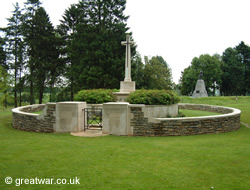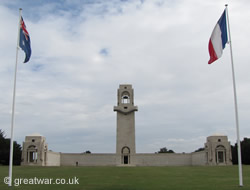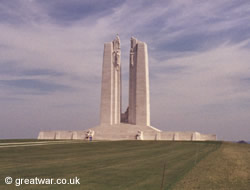Thiepval Memorial to the Missing, Somme Battlefields, France
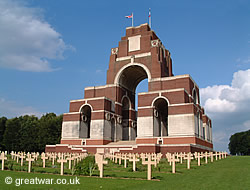
|
The Thiepval Memorial to the Missing of the Somme battlefields bears the names of 72,194 officers and men of the United Kingdom and South African forces.
These men died in the Somme battle sector before 20 March 1918 and have no known grave. The date of 20 March was the day before the German Army launched a large-scale offensive, codenamed “Operation Michael”, against the British Army Front in the sector of the Somme.
Over 90 percent of those commemorated on the Thiepval Memorial died in the 1916 Battles of the Somme between July and November 1916.
- An Anglo-French Memorial
- 1916 Somme Battles Commemorated
- Design of the Thiepval Memorial
- The Inscribed Names
- Search for Names on the Memorial
- Unveiling Ceremony
- Limestone Fossils
- Thiepval Visitor Centre
- Thiepval Database Project
- Location of the Thiepval Memorial
An Anglo-French Memorial
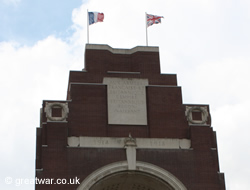
|
The Thiepval memorial serves as an Anglo-French Battle Memorial. It was designed as an arch representing the alliance of Britain and France in the Somme 1916 offensive against the German defensive Front.
British and French National Flags
The the British Union Jack and the French Tricolore are flown on the Thiepval Memorial to the Missing. On the uppermost part of the memorial building the British flag flies on the northern side and the French flag flies on the southern side. This is representative of the British Army being in action on the northern area of the 1916 Somme battlefield, north of the River Somme, and the French Army being in action on the southern area of the 1916 Somme battlefield, south of the River Somme.
Anglo-French Cemetery
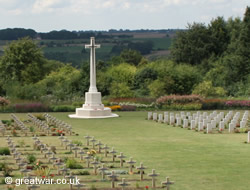
|
A cemetery with equal numbers of French and Commonwealth graves has been laid out at the foot of the Thiepval Memorial. The cemetery represents the shared sacrifice of these two nations in the Great War of 1914-1918.
1916 Somme Battles Commemorated
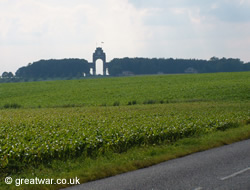
|
On the early morning of 1 July 1916, thirteen divisions of British forces launched an offensive on a line from north of Gommecourt to Maricourt at the River Somme. South of the river the attack was made by the French Army. The attack was preceded by a preliminary bombardment lasting seven days from 24 June. Although the German Front Line and rear positions were damaged by the Allied artillery during this time, and the Germans' nerves were severely tested by the end of the seven days, the German barbed wire defences were not as badly damaged as had been intended.
In the southern sector of the British attack, from Mametz village to Montauban village, the German defence did crumble and the British reached their objective there by the end of 1 July. However, in most other parts of the line the German defence held out and the British met with unexpected resistance from well-placed machine guns. In the far north of the sector from Gommecourt to Thiepval, numerous large bunkers dug deep underneath the chalk downs had provided enough protection in key strongpoint locations, such as Gommecourt, Serre, Beaumont-Hamel and Thiepval, for those German troops to survive the preliminary bombardment with few casualties. The losses to the British on the first day of the attack were unprecedented for the British Army, with approximately 58,000 casualties for that day alone including 19,000 of them being killed.
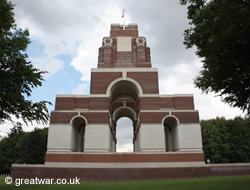
|
In the following weeks, the British continued to attack the German line in smaller-scale attacks with limited objectives. The German Army put up a stubborn resistance for every inch of ground. The battles of the Somme 1916 carried on over a period of several months from the first day of July to the middle of November. Every village, hamlet, farmhouse, wood and copse were fought over until the winter weather closed in. Only a few miles of ground were gained by the British by the end of the Battles of the Somme and huge numbers of men had been wounded or killed on both sides.
Thiepval Recaptured
The village of Thiepval, which had consisted of a few houses, a chateau and some outlying farms when the Germans first arrived here at the end of September 1914, was finally captured by the British at the end of September 1916. Exactly two years later. Originally one of the objectives of the first day of the Battle of the Somme on 1 July, Thiepval was successfully defended by the Germans for three months.
Somme Battle Honours
The names of quiet, rural villages and woods on the gently rolling chalk downs north of the Somme River became names associated with famous battles of 1916. In British military history these names would become synonymous with the sacrifice and bravery of the officers and men of the British Army and the Dominion Forces of Australia, Newfoundland, New Zealand and South Africa. The Thiepval Memorial carries the names of these battles on the corners of the piers: Albert, Gommecourt, Serre, Bazentin Ridge, Delville Wood, Pozières, Guillemont, Ginchy, Flers-Courcelette, Morval, Thiepval, Le Transloy, Ancre Heights.

The British continued to put pressure on the Germans throughout October and into November 1916. The weather closed in and the fighting went on, but the conditions were especially difficult. The ground over which the British were trying to move north-eastwards had been churned up by constant artillery bombardments, bodies from previous attacks lay unburied and decomposing, the weather was wet and cold and the hours of daylight grew less. The Battle of the Somme finally ended on 18 November 1916.
During the winter of 1916/1917 the German Army spent time adding to and newly constructing a system of defences stretching from the Belgian coast to the fortified city of Metz in Lorraine. This system of defences was called the Hindenburg Line. From 21 February 1917 the German forces on the Somme battlefield made a planned, tactical withdrawal to to a fortified section of the Hindenburg Line defences between Cambrai and St. Quentin. This section was called the Siegfried Stellung (the Siegfried Line). From this time there were no significant battle actions on the Somme battlefield sector until the Germans launched their major offensive in the spring of 1918 on 21st March. The Thiepval Memorial commemorates those who died on the Somme battlefield up to this date.
Design of the Thiepval Memorial
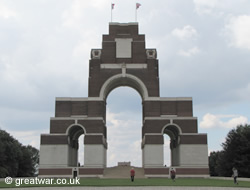
|
The Thiepval memorial was designed by Sir Edwin Lutyens. It was built in red brick and limestone between 1928 and 1932.
The memorial is located on a high ridge of ground and the top of the memorial can be clearly seen from various points of high ground in the centre and northern sectors of the 1916 Somme battlefields.
Scale Model
A scale model of the memorial can be seen in the Thiepval Visitor Centre (see below).
The Stone of Remembrance
The Stone of Remembrance, also known as the War Stone, is a feature of most of the British and Commonwealth military cemeteries and memorials. The Stone of Remembrance is situated in the raised section at the heart of the Thiepval Memorial and in the centre point of the arch.
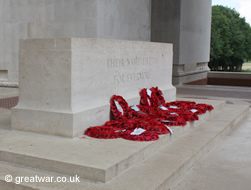
|
The words carved on every Stone of Remembrance, “Their Name Liveth For Evermore”, were suggested by Rudyard Kipling. The phrase is taken from Ecclesiasticus, Chapter 44, verse 14: “Their bodies are buried in peace; but their name liveth for evermore”.(1) Rudyard's son John was was killed in action at the Battle of Loos.
On occasions when ceremonies are held at the memorial, wreaths are laid here at the Stone of Remembrance.
The Inscribed Names
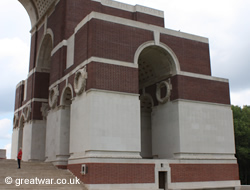
|
The 72,194 names of the men missing in action on the battlefield of the Somme are inscribed on 64 huge stone panels, which form each of the four faces of a total of 16 piers for the building.
A person standing on the steps of the memorial in the photograph shows the scale of this memorial.
The Registers of Names
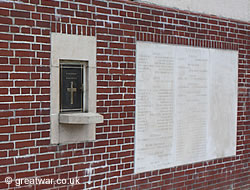
|
The name of each man commemorated on the memorial can be found in the Memorial Registers. These are a series of books listing the casualties on this memorial in alphabetical order.
The Memorial Registers are located in brass register boxes at the foot of the memorial by the steps leading to the Stone of Remembrance and on the terrace at the west end of the Memorial. A Visitors' Book is usually also present in the box for visitors to leave comments.
The Memorial Registers are provided by the Commonwealth War Graves Commission (CWGC). A copy of a Cemetery Register can be purchased from the CWGC at a low cost (see link below).
Individual's Details
The Memorial Register entry will usually provide (where known) most of the following details for an individual:
- Surname
- Rank
- Initial(s)
- Service Number
- Unit
- Regiment/Service
- Killed in action or Died of wounds
- Date of Death
- Age
- Next of kin and address
- Memorial Reference
Memorial Reference
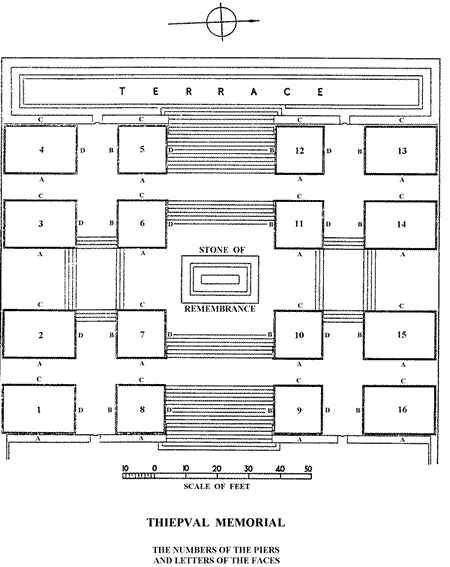
The Memorial Reference for the location of an individual's name on one of the stone panels will be given as “Pier and Face” followed by a number and a letter. As shown on the plan here, there are 16 Piers at the memorial numbered 1 to 16. Each Pier has four faces A, B, C and D (see the plan illustrated here).
The names of the individuals commemorated on the memorial are organised on the stone panels by regiment, and with so many names for each regiment represented, this may span across more than one of the faces of a pier. Within the listing for a regiment the names are also organized by battalion, and within each battalion they are organized in seniority of rank.
The Memorial Reference for an individual will be provided in the Cemetery Register as in the following example:
Butterworth, Lieutenant, George, GSK, MC, 13th Battalion, Durham Light Infantry: Pier and Face 14 A and 15 C.
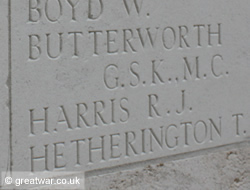
|
In this example, and looking at the memorial plan illustrated here, the name of Lieutenant George Butterworth will be found in a location under the listing for the Durham Light Infantry on Pier 14, Face A through to Pier 15, Face C. This is to the far right of the Stone of Remembrance on the plan. In fact, George Butterworth's name will be found listed under the 13th Battalion of this regiment and his name is on Pier 14 Face A.
Soldiers Lost and Found: Addenda
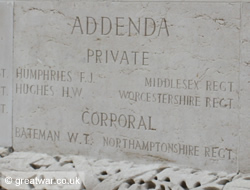
|
In some cases names of casualties have more recently been added to the Thiepval Memorial and they appear on panels marked as “Addenda”. Each case will have been carefully examined by the Commonwealth War Graves Commission, and for whatever reason they were not originally named on the memorial, but they have now been added to the thousands of names on this memorial. A reason for their addition to the memorial may be due to them being missing in action their name was not formally recorded in the correct location where they are believed to have been killed. Or it could be that their name did not appear on any memorial or grave until a family member tried to find them and this has led to their name subsequently being added.
Remains Discovered
A small number of approximately 130 casualties missing in action and named on the Thiepval Memorial when it was constructed in the early 1930s have been found since. It has been decided not to erase these soldiers' names, so they still remain on the memorial.
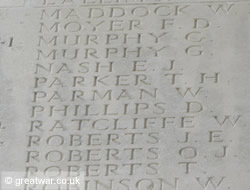 |
One such soldier is Corporal Thomas Henry Parker, who served with 2nd Battalion Royal Welsh Fusiliers. Corporal Parker was recorded as missing in action in the Front Line at Lesboeufs on 6 November 1916, one of the last few days of fighting in the Battle of the Somme. His name was recorded on Pier and Face 4 A together with other comrades in the 2nd Battalion. However, his body was discovered in the 1930s by a farmer ploughing his field after the Thiepval Memorial was built. Corporal Parker's remains were identified and buried in a marked grave with a headstone. He lies in London Cemetery near High Wood, Plot I, Row A, Grave 1. Corporal Parker's parents passed away before they knew that his remains had been discovered.
Search for Names on the Thiepval Memorial
Search the online “Debt of Honour” Register held by the Commonwealth War Graves Commission for names inscribed on the Thiepval Memorial. Go to this link and look in the Casualty Records at:
Website: www.cwgc.org CWGC Cemetery Record Search: Thiepval Memorial
Unveiling Ceremony
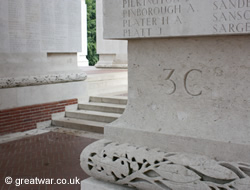
|
The Thiepval Memorial was unveiled on 31 July 1932 by Prince Edward, Prince of Wales. The new President of France, Albert Lebrun, was also officiating at the ceremony. He had succeeded President Paul Doumer a few weeks before in May after President Doumer was shot and died of his wounds on 7 May. On the same day as the Thiepval unveiling on 31 July President Lebrun also attended the unveiling of the Arras Memorial to the Missing and the Flying Services Memorial in Arras.
Limestone Fossils
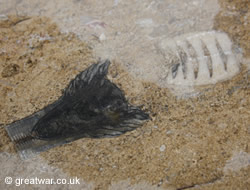
|
A fascinating feature in the limestone of this memorial is that fossils can be seen very clearly. A few metres from the War Stone there are ancient fossils exposed in the steps which lead away from the Stone of Remembrance between Piers 6 and 11 as you look out from the memorial towards the cemetery.
Thiepval Visitor Centre
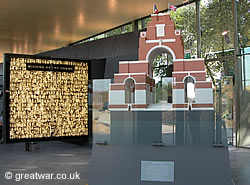
|
The Thiepval Visitor Centre is located a few hundred yards from the memorial. For information about the Centre and its facilities see our page at:
Thiepval Database Project
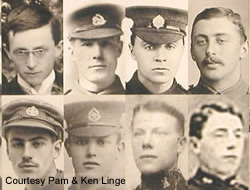
|
This is a project started by Pam and Ken Linge in 2003 to compile photographic and biographical details for all 72,000 men named on the memorial. If you have a relative on the memorial and would like to pass on information to the project see our page for more information:
Pam and Ken Linge have published a book about their research into the men commemorated on this memorial, called Missing But Not Forgotten. See our link in Related Reading below.
Location of the Thiepval Memorial
Latitude N 50° 3' 2 " ; Longitude E 2° 41' 10"
Thiepval Memorial to the Missing is located on the northern part of the 1916 Somme battlefields. It is north of the D929 Albert-Bapaume road, north-west of the village of Pozières. It can be reached from the D929 main road from Albert to Bapaume. In the village of Pozières on the D929 the Thiepval Memorial to the Missing is signposted. Driving south from Bapaume it will be signposted to the right to Thiepval on the D73. Driving north from Albert it will be signposted to the left to Thiepval on the D73.
Parking
There is parking at the Visitor Centre.
Visitor Facilities
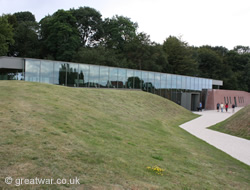
|
At the Visitor Centre there is an exhibition, shop, access to the database for the register of names, vending machines and toilets. (Open daily 09.30-18.00 hours from 1 March to 31 October and 09.30-17.00 hours from 1 November to 28 February.)
Related Reading

Missing but Not Forgotten: Men of the Thiepval Memorial - Somme [hardcover]
by Ken Linge and Pam Linge
This excellent book is published after more than 10 years of dedicated research into the men commemorated on the Thiepval Memorial to the Missing. Ken and Pam Linge are behind the Thiepval Database Project and have been collecting biographical information on the missing men since 2003. 288 pages. Published by Pen & Sword Military (2 Sept 2015), ISBN-10: 1473823587; ISBN-13: 978-1473823587
Related Topics
Cemeteries and Memorials on the Somme Battlefields
Cemeteries on the Somme Battlefields
Memorials on the Somme Battlefields
Battles of the Somme 1916
For an introduction to the Battles of the Somme 1916 see our page at:
Memorial to the Missing Australians
The names of Australians who fell in action during the First World War in France and Flanders and who have no known grave are commemorated on the Villers Bretonneux Memorial:
Memorial to the Missing Canadians in France
The names of Canadians who fell in action during the First World War in France and who have no known grave are commemorated on the Canadian National Vimy Memorial on the former Artois battlefield:
Canadian National Vimy Memorial
Memorial to the Missing New Zealanders in France
The names of New Zealanders who fell in action during the Battles of the Somme in 1916 and who have no known grave are commemorated on the Caterpillar Valley (New Zealand) Memorial, Longueval:
Monuments on the Somme Battlefields
Memorial to the Missing Newfoundlanders
At the time of the First World War the Dominion of Newfoundland provided a battalion of about 800 men which served as the 1st Newfoundland Regiment with the British Army. The memorial to the 814 missing of the Newfoundland Regiment is situated at Newfoundland Park on the Somme battlefield:
Commonwealth War Graves Commission (CWGC)
For information about the work of the CWGC and for education resources visit the website:
Website: www.cwgc.org
Acknowledgements
(CWGC) Plan of the Thiepval Memorial courtesy of the Commonwealth War Graves Commission.
(1) Source: The King James Bible.
The Commonwealth War Graves Commission: For further information about the work of the Commonwealth War Graves Commission (CWGC) you can visit the website:
Website: www.cwgc.org


